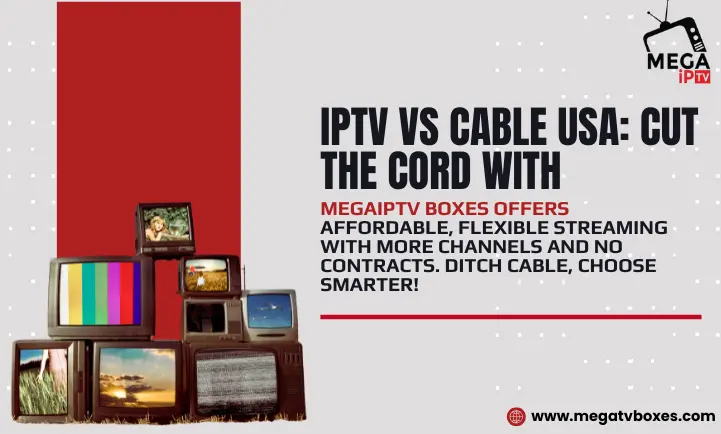It’s a world of entertainment options on an endless loop, and you are paralyzed by too many choices. With the growing popularity of online services, many are wondering if IPTV vs cable USA is the best choice for their home. Millions of people still use the traditional cable to access television, but IPTV platforms like Mega IPTV Boxes are getting their feet wet (quite easily), particularly for those who love a little flexibility, while having access to diverse content for Indian channels IPTV.

This article breaks down the comparison between IPTV vs cable USA, helping you make an informed decision based on features, costs, and viewing experience.
Understanding the Basics
Before we elaborate further in this IPTV vs cable USA discussion, let’s get an understanding of what each service gives us.
- Coaxial cables that used to transmit television programming to your TV set via cable TV. A mainstay in American homes for decades, it offers hundreds of channels grouped into fixed packages.
- On the other hand, IPTV (Internet Protocol Television) transmits the content over the Internet. Services such as Mega IPTV Boxes offer live TV, on-demand shows, and movies through apps or smart devices. This model is becoming increasingly popular for users seeking flexible, device-friendly viewing, including those looking for Indian IPTV Subscription plans.
IPTV vs Cable USA: The Main Differences
When you’re deciding on IPTV vs cable USA, there are a few key differences that might influence how you watch:
- Delivery Method
- Cable TV How it works: Cable TV broadcasts signals to your home through physical connections.
- IPTV uses your Internet connection to play TV programs, removing the need for cable or satellite TV.
- Flexibility
- With cable, you’re mostly shackled to your TV set and, often, to a particular provider’s box.
- IPTV lets you watch on smart TVs, laptops, tablets, and smartphones, giving you the freedom to view content anywhere with internet access.
- Content Selection
- What Cable TV Provides Cable services offer standard packages that include local and cable channels, movies, and sports.
- IPTV can also offer more specialist content, including IPTV for Indian channels, IPTV international, and specific packages that cater to an eclectic range of preferences.
- Cost Structure
- Cable TV commonly comes with monthly contracts, equipment leasing fees, and taxes.
- IPTV generally has simpler pricing (monthly subscription model, no new equipment costs)
Advantages of IPTV
Let’s look at why many people are leaning towards IPTV in the IPTV vs cable USA debate:
- Device Compatibility
And because of the way it’s drafted, IPTV can work on a wide array of devices — from TVs to phones — without needing additional hardware. - Custom Content
You can even choose subscriptions, such as an Indian IPTV Subscription, to access particular regional content that you may not get on cable. - On-Demand Viewing
The majority of IPTV providers will have VOD (video-on-demand) functionality. This is a feature that many have, and the advantages of VOD are enormous. This means you can select any TV show, movie, or radio show when you want to watch it. - Portability
With a reliable internet connection, you can access your IPTV service wherever you go — perfect for frequent travelers and people who migrate between homes. - No Long-Term Contracts
Many IPTV services, including Mega IPTV Boxes, offer flexible plans that don’t tie you into lengthy agreements.
Advantages of Traditional Cable
There are many advantages of using IPTV, but cable TV also has advantages over IPTV:
- Reliable Signal Quality
Cable TV doesn’t rely on internet speeds, so you’re less likely to get itchy buffering fingers during high usage hours. - Local Channels and Sports
Local channels, regional sports, network news avaiable locally and more — things that may not be available or are delayed on a few IPTV services — are often better via cable. - Bundled Deals
Service providers frequently package TV, internet, and phone service, possibly saving you money.
IPTV vs Cable USA: A Point-by-Point Comparison
Here’s a clear, point-wise breakdown of key differences between IPTV vs cable USA:
- Installation
- Cable: Requires technician visits, cable boxes, and setup.
- IPTV: Quick self-setup using apps or streaming devices.
- Flexibility
- Cable: Limited to physical connection points.
- IPTV: Watch anywhere with internet.
- Content
- Cable: Standard local and national channels.
- IPTV: Access to global content, including IPTV for Indian channels.
- Equipment
- Cable: Set-top box, remote, cables.
- IPTV: No special equipment beyond what you already own.
- Cost
- Cable: Higher monthly costs, equipment rental fees.
- IPTV: Typically lower cost, no rental fees.
- On-demand content
- Cable: Often limited.
- IPTV: Extensive libraries included.
Internet Dependency: A Key Factor
One of the most important considerations in the IPTV vs cable USA decision would be your internet availability. It is the quality of the internet connection that indeed filters the functionality of IPTV. Without it, you might have lag, buffering, or poor video quality. Cable TV, meanwhile, doesn’t rely on your internet, which can be more necessary for families in areas with less than stellar service.
The Role of Regional Content
For most viewers, the comparison of IPTV vs cable USA would be largely driven by regional and cultural content. Mega IPTV Boxes has options for various subscriptions for Indian IPTV. Some Indian channels can also be covered under this, like Hindi, Tamil, Telugu, Punjabi, and other Indian languages. Many traditional cable providers either have poor international support or artificially inflated package costs that often make little sense for a relatively few channels.
Cost Considerations
When comparing IPTV vs cable USA, keep in mind more than the monthly fee:
- Cable TV prices can skyrocket because of set-top boxes, DVR, HD, sports fees, and other taxes.
- IPTV prices also tend to be a little more cut and dry, with options like Mega IPTV Boxes offering flat-rate plans that include everything from live TV to on-demand shows. And you don’t have to pay for equipment you don’t use.
User Experience
The user interface and experience also play a significant role when deciding between IPTV vs cable USA:
- IPTV services also tend to have modern, app-based interfaces with advanced search features and browsing options, and can also include handy options for preserving on-demand content.
- Cable services depend on the conventional remote control and guide menu and some users might find it a bit old-fashioned when compared to the slick apps of IPTV.
The Final Choice: IPTV vs Cable USA
Finally, deciding between IPTV vs cable USA is about what’s best for your household. If you require flexibility, custom content as IPTV for Indian channels, and reduced cost, the IPTV Service is a better option. But if you want good picture quality without access to the news and don’t want your viewing experience tied to your internet connection, cable TV remains a good option.
And keep in mind that many households use them both: basic cable for local channels, augmented by IPTV for their more specialized and international browsing tastes.
Conclusion
The battle of IPTV vs cable USA mirrors a wider change in how people watch television today. Mega IPTV Boxes services offer added ease, better quality, advanced global coverage, and lower prices that all the cable users around the world dream of. Still, cable TV is a solid option, especially if you’re seeking something simple and local, and aren’t sure your connection can handle the stress of consistent streaming.
If you are more concerned about getting access to the broadest possible variety of channels — as one might with an Indian IPTV Subscription — along with the possibility of watching content on multiple devices, then IPTV is the solution. Before you make a decision, consider how reliable your internet is, what kind of content you prefer and how much you’re willing to pay so you can pick the service that’s best for you.



